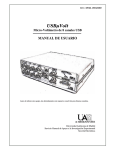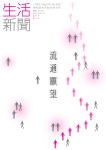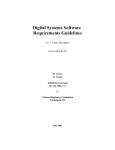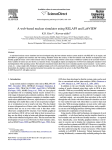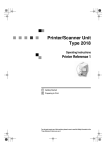Download Unavailability Analysis of Digital Engineered Safety Feature
Transcript
Proceedings of the Korean Nuclear Spring Meeting Gyeong ju, Korea, May 2003 Unavailability Analysis of Digital Engineered Safety Feature Actuation System Hyun Gook Kang*, Sudarno Wiharjo**, Seung-Cheol Jang* * Korea Atomic Energy Research Institute, P.O Box 105, Yuseong, Daejeon, 305-600 [email protected] ** National Nuclear Agency-BATAN, Gedung 80, Serpong, Tangerang 15310, Indonesia Abstract This paper quantitatively presents the results of the fault tree analysis of Digital Engineered Safety Feature Actuation System which is one of the most important signal generation systems in nuclear power plant because it generates the signal for mitigating possible accidents. In this paper, as an example, we explore the case of auxiliary feedwater actuation signal. Based on the analysis results, we quantitatively explain the relationship between the important characteristics of digital systems and the system unavailability. Similarly to the PSA result of Digital Plant Protection System, we find out some factors remarkably affect the system unavailability. They are the common cause failures and the coverage of fault tolerant mechanisms. Human operator’s backup also plays very important role. In this analysis we ignore the effect of software failure. We also compare the result with the PSA result of conventional analog Engineered Safety Feature Actuation System. 1. Introduction It is widely recognized that sophisticated probabilistic safety assessment (PSA) techniques are critical in estimating the frequency of accidents in complex engineered systems such as nuclear power plant, aviation, aerospace, and chemical processing plant. It has been used to assess the relative effects of contributing events on system-level safety or reliability. The approach used in PSA is to model the system in terms of its components, stopping where substantial amounts of data are available for all of the key components. The accuracy of the result depends on the accuracy of the PSA model itself, but there are good reasons to believe that the accuracy of PSA models has improved over time. Despite the efforts to avoid undesirable risks, or at least to bring them under control using PSA techniques, however, new risks that are highly difficult to manage continue to emerge from the use of new technologies, such as the use of digital instrumentation and control (I&C) components in nuclear power plants. Whenever new risk issues come out, we have endeavored to find the most effective ways to reduce risks, or to allocate limited resources to do this. One of the major challenges remaining for the current PSA is the difficulty of assessing risk for digital safety-critical system, or microprocessor-based computer systems. In particular, Korean Standard Nuclear Power Plants (KSNPPs), typically Ulchin 5 & 6 nuclear units, adopted the digital safety-critical systems such as Digital Plant Protection System (DPPS) and Digital Engineered Safety Feature Actuation System (DESFAS), due to the obsolescence of traditional analog components and the functional advantages of digital systems. We reported some results regarding the DPPS PSA [1][2]. In this paper, we are focusing on the DESFAS PSA. The DESFAS is one of the most important signal generation systems in a nuclear power plant because it generates the signal for mitigating possible accidents. Engineered Safety Feature (ESF) is actuated by the automatically generated signals of the DESFAS or by human operator’s manual signal. The signal of the DESFAS consists of several vitalfunction actuations: Safety injection, containment isolation, recirculation, main steam isolation, and auxiliary feedwater actuation. If the DESFAS is unavailable, the safe operation of the nuclear power plant totally relies on the human actions. Though there are some difficulties in applying the conventional PSA to the digital systems, we develop a fault tree model for assessing the unavailability of the DESFAS. In section 2, we will describe the information of the DESFAS and modeling assumptions. In section 3 and 4, we will explain the fault tree modeling of the DESFAS and quantification results, respectively. 2. DESFAS Description and Modeling Assumptions A. Description of DESFAS The DESFAS provides automatic signal processing in the case of following signals are received from the DPPS based on selective two-out-of-four logic. - Safety injection actuation signal (SIAS), - Containment isolation actuation signal (CIAS), - Recirculation actuation signal (RAS), - Main steam isolation signal (MSIS), - Auxiliary feedwater actuation signal – 1 (AFAS-1) - Auxiliary feedwater actuation signal – 2 (AFAS-2) The DESFAS is comprised of two independent and redundant trains of equipment housed in separate auxiliary cabinets. The successful operation of one out of two train implies the successful functioning of ESF. The DESFAS is designed based on programmable logic controllers (PLCs). Figure 1 and 2 shows the schematic diagram of the DESFAS configuration and the signal flow diagram from the DPPS to field actuators, respectively. Four independent instrumentation channels provide sensing signal to DPPS. The DPPS consists of four independent channels also. Each channel of the DPPS automatically generates ESF actuation signal for the DESFAS if the sensing signal reaches the preset point. Two trains of the DESFAS receive the ESF actuation signals from four channels of the DPPS independently. DESFAS initiation signals are received from the DPPS through fiber optic receivers to maintain channel independence. Figure 2 shows the signal flow in one channel of DESFAS. In a typical train, the initiation signals are distributed to two sets of PLCs. Signals for pumps are processed by one set of PLCs and the signals for valves are processed by another set of PLCs. Each set of PLCs consists of two processor modules and input/output modules. Coincidence logic is implemented in each of the sets of PLCs for the pump and valve actuation. That is, there are totally four PLC processor modules. Two of them are for pump actuation and the others are for valve actuation. Each coincidence logic in PLC performs logical ‘OR’ on two input signals from respective DPPS channels (A&C or B&D) and provides output to the appropriate optocouplers. Each opto-coupler performs logical ‘AND’ on two signals from respective PLC processor modules. Then finally we get selective two-out-of-four logic for validating the ESF initiation signals from four DPPS channels. Signal from opto-coupler is provided as an input for Plant Control System (PCS), which contains the field actuator control logics. Human operators could initiate or actuate the DESFAS signal manually. If an operator pushes buttons for manual initiation, the signal is generated by the DPPS and forwarded to the DESFAS. In this case, the process after receiving by DESFAS is same as that of automatically generated signals. If an operator turns on the switches for manual actuation, the actuation signal is generated directly as shown in Figure 2. B. Modeling Scope and Assumptions We developed fault tree models for all kinds of ESF signals listed above. However, for the convenience and efficiency of explanation, in this paper, we will explain only the case of AFAS-1. AFAS-1 has simple input structure. The developed fault tree model covers from the field sensors to the opto-couplers. The scope of modeling includes digital equipment and conventional analog equipment. The digital components considered in this modeling are analog-to-digital input modules, bistable (BS) processors, local-coincidence-logic (LCL) processors, digital output modules, digital input modules, and coincidence logic (CL) processors in the DPPS and the DESFAS. We also consider the human action failures and the watchdog timers’ coverage for the BS, LCL and CL processor modules. In this study, however, we do not consider the failure of software programs which are installed in the BS, LCL and CL processors. The top event of the fault tree could be defined as ‘failure of ESF actuation signal generation under the demand of actuation’. This event includes not only the DESFAS and its belongings but also includes the human operator’s manual actuation of ESF. Therefore, strictly speaking, the model is not for the DESFAS’s unavailability but for the unavailability of the ESF signal generation mechanism. Assumptions of this model are as follows: - The failure of field actuators such as pumps and valves and their controllers (PCS) are not included in this fault tree model because we consider that they are out of system boundary. - The equipment/components such as indicators, alarm systems and testing facilities which do not affect on the successful actuation of ESF are not considered in this model. Opto-couplers which provide the signal for Plant Data Acquisition System (PDAS) and Plant Annunciator System (PAS) are also excluded in this model. - Usually safety-critical components are activated in normal operation condition. Therefore the fault could be detected in operation. However, we assume that a fault can be found by testing only. - As explained above, there are two means for manually actuating or initiating the ESF. One is pushing buttons for manual initiation and the other is turning on the switches for manual actuation. We consider the mechanical failures of push buttons and switches separately and independently. However, we use single event for human operator’s failure because human actions related to those two means are very strongly coupled. - Two remote manual switches are available for actuating each train of each ESF. The human actions to close both switches are assumed to be completely coupled. Therefore, we use single event for these two actions. That is, we consider only one event for human failures of manual ESF actuation. - Bypass testing of components might affect on the system unavailability. However, we do not consider it. - Operators could bypass the channel in the DPPS in the case of channel failure. It would cause the change of system structure from two-out-of-four to two-out-of-three and a fault tree should be reconstructed for adequately reflecting the change. However we ignore the effect of this change. - We assume the testing period of instrumentation sensors and that of signal processing components as one year and one month, respectively. Digital component might be tested more frequently using automated algorithms. However the quantitative estimation of those algorithms’ validity is not available, so we ignore the effect of automatic testing. - Human operators act only in the case of automatic signal generation failure. Therefore, in order to get the human failure probability, the detailed analysis which considers both of processing system failure and instrumentation sensor failure is required. However, we assume the failure probability of human as 0.05 as shown in reference [3] because the accurate analysis is not performed yet. - The reliable results on the estimation of fault coverage of watchdog timers are not available. Therefore we assume the watchdog timers coverage as 0.3, which is similar to the reference [1]. This value is applied to the CL watchdog timers and the LCL watchdog timers. - In the case of monitoring mechanism between BS processors and LCL processors, we could give more credit than in the case of watchdog timer. We assume 0.01 as the probability that a LCL processor fails to detect the failure of a BS processor. For the convenience of modeling we multiply the probability to the failure rate of BS processors. The detailed explanation for the assumptions could be addressed in our technical report [4] which is in its draft form now. 3. Fault Tree of DESFAS A. Data There are two kinds of data in the DESFAS fault tree. Some parts of the system consist of conventional analog/mechanical components but the others include new-coming digital components. For digital parts, because the operation data for the same type PWR was unavailable, we used the data provided by vendors as shown in the reference [3]. On the other hand, for the conventional analog/mechanical parts, we used experience data presented in the other reference [5], [6]. Based on the failure rates acquired from the references, in the case of AFAS-1, we calculate the failure probabilities of 264 basic events including 17 common cause failure (CCF) events. In this calculation we consider following factors: Operation mode Test period Test validity Test method (CCF only) The connection structure of common components (CCF only) CCF parameter estimation method (CCF only) Detailed data could be accessed in the reference [4]. B. Fault Tree Structure Figure 3 shows the schematic fault tree for the failure of AFAS1-signal-generation function. The fault tree for the AFAS-1 function failure consists of two kinds of events, which are connected with logical AND. One is the failure of AFAS1 train A. The other is the failure of train B. It means that if one train out of two is successfully initiated, the mission of AFAS-1 could be successfully completed. Each train consists of pump actuation signals and valve actuation signals. Both of pump signals and valve signals are needed for successful functioning of each train. Signal generation consists of two kinds of sources. One is the automatic generation of signal by digital processing components and the other is the human operator’s manual signal generation. When we go into the failure of automatic signal generation, there are combinations of digital and analog components, which could be grouped as related to input failure, signal processing failure, and output generation failure. Inputs of the DESFAS are generated by the DPPS and transferred through digital input/output modules and optical modems. Because a watchdog timer monitors a processor module, we have to consider the fault coverage of a watchdog timer when we model the failure of signal processing. Output of the DESFAS is generated using digital output modules. Figure 4 shows the typical fault tree for the failure of signals from the DPPS to the DESFAS. Input failure consists of I/O part and the DPPS part. The I/O part consists of digital input/output modules and optical transmitters/ receivers. The DPPS part consists of failure of processor modules, watchdog timers for DPPS processor modules, analog-todigital input modules, and sensors. 4. Results of Quantification Using KwTree [7], which is the fault-tree analysis software package produced by Korea Atomic Energy Research Institute, we perform the quantification of AFAS-1 fault tree. The result of quantification shows that the system unavailability of the DESFAS is 5.463E-5. The main contributors of this unavailability are summarized in Table 1. The most dominant cutset is ‘sensor CCF & human failure’. The other cutsets are closely related to the CCF of digital components. When we consider the functional backups in plant design, it is notable that the CCF of sensors could be complemented by different sensors but the CCF of digital components does not have backups. The results in the unavailability report for KSNPP’s analog ESFAS [6] show that the system unavailability of analog type AFAS-1 is 5.09E-6. However, in the assumptions of reference [6], it adopts quite different assumption for the human failure probability (3.68E3). When we consider the difference of assumptions for the human failure probability, the system unavailability in the reference might be around 7E-5, which is about 27% higher than the unavailability of the DESFAS. 5. Concluding Remarks The result of PSA plays very important role in proving the safety of a designed system. Digital safety-critical systems which are now installed in KSNPP would be quantitatively evaluated. In this study, we quantified the safety of the DESFAS in KSNPPs using PSA technology. The system unavailability is estimated as 5.463E-5 in case of AFAS-1 of DESFAS, which is about 27% less than that of analog system. From the results, we can determine the several important factors: Human failure probability, watchdog timer coverage, and common cause failure estimation. Software failure probability, even though it is not considered in this study, would be expected to play important role because it would affects on the CCF probability of processor modules. These factors should be more carefully investigated because we have showed that the system unavailability was very sensitive to them [2]. The results of this study could be utilized in risk-effect analysis of KSNPP. We expect that the safety analysis result will provide design feedback. Acknowledgement This work has been carried out under the Nuclear R&D Program supported by MOST Reference [1] Hyun Gook Kang, et al., "Reliability Study: Digital Reactor Protection System of Korean Standard Nuclear Power Plant," KAERI/TR-2419/2003. [2] Hyun Gook Knag and Taeyong Sung, “An analysis of safety-critical digital systems for risk-informed design,” RESS, Vol. 78, 2002. [3] Westinghouse, Unavailability analysis for the digital plant protection system, ST-99-231. [4] Hyun Gook Kang, et al., “Reliability Study: Digital Engineered Safety Feature Actuation System of Korean Standard Nuclear Power Plant,” KAERI/TR-2467/2003. [5] 민경란 외, 신뢰도 상세분석: 표준원전 원자로보호계통, KAERI/TR-2164/2002, 한국원자력 연구소, 2002. [6] 민경란 외, 신뢰도 상세분석: 표준원전 공학적안전설비 작동계통, KAERI/TR-2165/2002, 한 국원자력연구소, 2002. [7] Sang Hoon Han, et al., “User’s Manual for KIRAP (KAERI Integrated Reliability Analysis code Package) Release 2.0,” KAERI/TR-361/93, 1993. Table 1. The main cutsets of AFAS-1 fault tree No. Prob. F-V 1 3.66E-05 0.67 Human 2 4.97E-06 0.0909 Human 3 2.21E-06 0.0404 Human 4 2.05E-06 0.0374 Human 5 1.90E-06 0.0348 Human 6 1.90E-06 0.0348 Human 7 9.95E-07 0.0182 Human DPPS AI CCF 8 3.99E-07 0.0073 Human DPPS LCL PM DPPS LCL WDT CCF Coverage 9 3.54E-07 0.0065 Human DPPS DO CCF 10 1.26E-07 0.0023 Human Combinations of DESFAS DO Human Combinations of Sensor Human DESFAS DO DESFAS DO CCF DPPS BS PM CCF DESFAS PM CCF Manual Relay Power CCF … 25 1.26E-07 0.0023 26 2.88E-08 0.0005 27 2.88E-08 0.0005 28 2.88E-08 0.0005 29 2.88E-08 0.0005 30 2.81E-08 0.0005 … Events 61 2.81E-08 0.0005 62 1.59E-08 0.0003 Manual Relay Power CCF 63 1.33E-08 0.0002 Human 64 7.06E-09 0.0001 Manual Relay Power CCF 65 6.54E-09 0.0001 DESFAS DI CCF Sensor CCF DESFAS DO CCF DESFAS PM CCF DESFAS WDT Coverage DESFAS DI CCF Optical Transmitter CCF Optical Receiver CCF DESFAS WDT Coverage DESFAS WDT Coverage DESFAS PM Figure 1. The schematic diagram of the DESFAS configuration DPPS POWER A POWER B POWER DIST. POWER DIST. AC (1) BD (1) (2) DESFAS AUXILIARY CABINET LOCAL MANUAL ACTUATION AND RESET (4) COMMUNICATION INTERFACE PROCESSOR MAINTENANCE AND TEST PANEL ISO ISO FOR P L C P L C OPTO ISO PUMPS I/O MAIN CONTROL ROOM FOR OPTO ISO P VALVES I/O L C P L C ACTUATION SWITCHES (4) OPTO COUPLERS (3) OPTO COUPLERS PCS PLANT PUMPS/VALVES PAS ESF DIVERSE MANUAL ACTUATION PANEL OPTO COUPLERS PDAS DATA LINK HARDWIRED INTERFACE FIBER OPTIC Figure 2. The signal flow diagram from the DPPS to field actuators AFAS1 Trai n A B fai l to actuate TOP-AFAS1 AFAS1 Trai n B fai ls t o actuate AFAS1 Trai n A fai ls t o actuate TR -B-AFAS1 TR -A-AFAS1 Failure t o generate VALVE act . signal for AFAS1 Failure t o generate PUMP act. signal for AFAS1 VA-AFAS1 PA-AFAS1 Train A OCs fail to gen. PUMP act signal Failure t o gen. aut o man. PUMP AFAS1 signals for t rain A OCPA-AFAS1 PAMA-AFAS1 Failure t o generate remote manual PUMP AFAS1 for t rain A Pump group CL PM fail s to generate actn. signal for train A PMA-AFAS1 PPMA-AFAS1 Pump group CL -P2A fail s to generate actn. signal Pump group CL -P1A fail s to generate actn. signal POMP2A-AFAS1 POMP1A-AFAS1 Figure 4 Failure of pump CL -P1A watchdog WD-P1A Pump proc. DO module CL -P1A fails to generat e signal Failure of initn. signals from DPPS ch. AC t o DE SFAS PMW DP1 A OMP1 A-AFAS1 PAAC-AFAS1 CCF OF CL -PM prevent s to gen. ACT SIGNAL INDE PENDENT Fai lure PM CL-P1A to provide act output DO modul CL-P1A slot 15 fail s to generate act. signal. CCF of CL Digit al Out put modul e PMCCF PMINDP1 A FSOMAP1 A15 FSOMWDO Comm on cause fai lure of CL-PM modul e W AT CHDOG T IME R FAILS Pump CL -P1A fails to provide actution output W AT CHDOG T IME R W D-P1A FAIL S FSPMW WDC CF FSPMAP1A WDP1A W D FAILS TO DE TE CT CCF OF CL -PM W D DET ECTS FAUL T BUT FAIL S TO RE COVE R W D P1A FAIL S TO DE TE CT FAULT OF CL -P1A W D P1A DE TE CT S FAULT BUT FAIL S TO RE COVE R FSWDJPCCF WDR CVCCF FSWDJP1A WDR CVP1 A W D DET ECTS CCF OF CL -PM Comm on cause fai lure of warchdog t imer mech. switch devices W AT CHDOG P1A FAIL S TO RECOVER W D V1A DET ECTS FAULT OF CL-P1A FSWDJXCCF FSWDW WDSWP1A FSWDJXP1A FAILURE OF W D DE VICE /SWITCH P1A Comm on cause fai lure of warchdog t imer mech. switch devices FSWDDP1A FSWDW Figure 3. The schematic fault tree for the failure of AFAS1-signal-generation function Failure of initn. signals from DPPS ch. AC to DESFAS PAAC-AFAS1 Ch. C fails to generate signal for CL P1A Ch. A fails to generate signal for CL P1A P1 AC -AFAS1 P1 AA-AFAS1 DI module P1A for ch. A fails to transmit init. signal Failure of initiation signal from DPPS ch. A for DESFAS TR A IMP1AA-AFAS1 R PAA-AFAS1 Failure of DESFAS channel A fiber optic receiver (Train A) Failure of DPPS channel A fiber optic transmitter (train A) Failure to generate initiation signal in DPPS channel A ORAA-AFAS1 GRPOTAA-AFAS1 GRPAFS-AFAS1 Failure to generate AFAS1 DPPS manual init. signal for ch. A FAIL TO GENER. INIT. SIGNAL IN CH. A AFAS1 GRPFSMA-AFAS1 GRPFSA-AFAS1 FAILURE OF PATH LCL A2/A4 to init. AFAS1 FAILURE OF PATH LCL A1/A3 to AFAS1 GRPSA24-AFAS1 GRPSA13-AFAS1 LCL A3 FAILS TO GENERATE INIT. SIGNAL AFAS1 LCL A1 FAILS TO GENERATE INIT. SIGNAL AFAS1 GRPLLA3-AFAS1 GRPLLA1-AFAS1 FAILURE OF INPUT FROM BS A1/D2/B1/C2 LCL DO A1 fails to generate init. signal AFAS1 LCL MOD A1 WD TIMER A1 FAILS TO GENERATE TRIP GRPLLIMX-AFAS1 GRPLLOMA1 -AFAS1 GRPLLPW A1 3 BS A1 FAILS TO GENERATE LCL INPUT BS B1 FAILS TO GENERATE LCL INPUT BS C2 FAILS TO GENERATE LCL INPUT BS D2 FAILS TO GENERATE LCL INPUT CCF OF DIGITAL OUTPUT MODULES FAILURE OF DIGITAL OUTPUT MODULE A1 GRPBIA1-AFAS1 GRPBIB 1-AFAS1 GRPBIC 2-AFAS1 GRPBID2-AFAS1 R POMW R POMRA1 BS PM A1 FAILURE NOT DETECTED BY LCL FAILURE OF INPUT TO BS CHANNEL A GRPBIPMA1-AFAS1 GRPBIIMA-AFAS1 Figure 4. The schematic fault tree for the failure of signals from the DPPS A&C to the DESFAS













